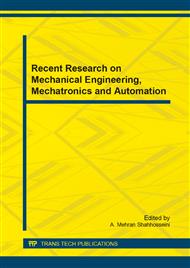p.569
p.577
p.581
p.588
p.596
p.603
p.609
p.615
p.621
Parallel Vibration Isolation Platform Using Magnetorheological Technology
Abstract:
Within this work, a six-axis parallel vibration isolation platform with semi-active control ability is investigated. Traditional magnetorheological (MR) dampers could supply large output force and long stroke, but it also comes with a large self-weight. This problem is more serious when several MR dampers are needed in a parallel platform. Firstly, a double-piston MR damper have been developed, which will brings a small self-weight feature to the damper. Hyperbolic tangent model have been used to describe damper's nonlinear hysteresis. Using six of this double-piston MR damper, a parallel vibration isolation platform based on a cubic Stewart platform mechanism has been designed. Dynamical model of this platform has been built and simulated. Numerical simulation results in frequency domain indicate that the parallel semi-active vibration isolation platform has desirable vibration isolation properties in all six axes.
Info:
Periodical:
Pages:
596-602
Citation:
Online since:
July 2014
Authors:
Price:
Сopyright:
© 2014 Trans Tech Publications Ltd. All Rights Reserved
Share:
Citation:


